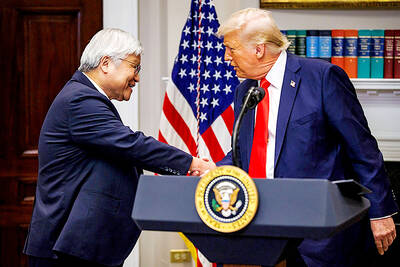The US government was yesterday hours from shutting down after the far right of the Republican Party scuppered final attempts at a temporary budget agreement, throwing into doubt everything from access to national parks to Washington’s massive support for Ukraine.
The closure of all but critical government services, set to start after midnight on Saturday if lawmakers failed to reach a deal, would be the first since 2019 — immediately delaying salaries for millions of federal employees and military personnel.
The two chambers of the US Congress were deadlocked, with a small group of Republicans in the US House of Representatives pushing back against stopgap measures that would at least keep the lights on.

Photo: EPA-EFE
On Friday, House Republicans defeated a plan proposed by their own leader, House Speaker Kevin McCarthy, to keep funds flowing, deepening the sense of growing chaos within the party ahead of next year’s elections where former US president Donald Trump hopes to return to the White House.
US Office of Management and Budget Director Shalanda Young said there was “still a chance” of avoiding a shutdown if Republicans could end internal divisions.
White House press secretary Karine Jean-Pierre made it clear that President Joe Biden, who is seeking a second term next year, did not intend to wade in.
“The conversation needs to happen between Speaker McCarthy and his caucus. That’s the fix, that’s the chaos that we’re seeing,” she said.
Speaking to the news outlet ProPublica on Friday, Biden said that McCarthy has made “a terrible bargain. In order to keep the speakership, he’s willing to do things that he, I think, he knows are inconsistent with the constitutional processes.”
However, McCarthy blamed Democrats, saying they are the ones blocking a solution.
All critical government services would remain functioning, but a shutdown would mean the majority of national parks would be closed to the public from today, but a prolonged shutdown could cause bigger disruptions.
A shutdown “unnecessarily” places the world’s largest economy at risk, White House National Economic Council Director Lael Brainard told CNBC.
Risks that could percolate through the wider economy include air travel delays, with air traffic controllers asked to work without pay.
US Secretary of the Treasury Janet Yellen said that a closure could also delay infrastructure improvements.
“In the immediate term, a government shutdown will only reduce GDP by 0.2 percentage points each week it lasts,” said a report released Friday by the Center for Strategic and International Studies think tank.
“However, halting critical trade functions of the United States will also undermine the United States’ overall credibility as a commercial partner, impede ongoing negotiations and hinder export control enforcement capabilities,” the report added.
The mess casts a growing shadow over Biden’s policy of arming and funding Ukraine in its desperate war against the Russian invasion. For Republican hardliners behind the derailment of a new budget, stopping aid to Ukraine is a key goal.

CRITICAL MOVE: TSMC’s plan to invest another US$100 billion in US chipmaking would boost Taiwan’s competitive edge in the global market, the premier said The government would ensure that the most advanced chipmaking technology stays in Taiwan while assisting Taiwan Semiconductor Manufacturing Co (TSMC, 台積電) in investing overseas, the Presidential Office said yesterday. The statement follows a joint announcement by the world’s largest contract chipmaker and US President Donald Trump on Monday that TSMC would invest an additional US$100 billion over the next four years to expand its semiconductor manufacturing operations in the US, which would include construction of three new chip fabrication plants, two advanced packaging facilities, and a research and development center. The government knew about the deal in advance and would assist, Presidential

‘DANGEROUS GAME’: Legislative Yuan budget cuts have already become a point of discussion for Democrats and Republicans in Washington, Elbridge Colby said Taiwan’s fall to China “would be a disaster for American interests” and Taipei must raise defense spending to deter Beijing, US President Donald Trump’s pick to lead Pentagon policy, Elbridge Colby, said on Tuesday during his US Senate confirmation hearing. The nominee for US undersecretary of defense for policy told the Armed Services Committee that Washington needs to motivate Taiwan to avoid a conflict with China and that he is “profoundly disturbed” about its perceived reluctance to raise defense spending closer to 10 percent of GDP. Colby, a China hawk who also served in the Pentagon in Trump’s first team,

SEPARATE: The MAC rebutted Beijing’s claim that Taiwan is China’s province, asserting that UN Resolution 2758 neither mentions Taiwan nor grants the PRC authority over it The “status quo” of democratic Taiwan and autocratic China not belonging to each other has long been recognized by the international community, the Mainland Affairs Council (MAC) said yesterday in its rebuttal of Beijing’s claim that Taiwan can only be represented in the UN as “Taiwan, Province of China.” Chinese Minister of Foreign Affairs Wang Yi (王毅) yesterday at a news conference of the third session at the 14th National People’s Congress said that Taiwan can only be referred to as “Taiwan, Province of China” at the UN. Taiwan is an inseparable part of Chinese territory, which is not only history but

INVESTMENT WATCH: The US activity would not affect the firm’s investment in Taiwan, where 11 production lines would likely be completed this year, C.C. Wei said Investments by Taiwan Semiconductor Manufacturing Co (TSMC, 台積電) in the US should not be a cause for concern, but rather seen as the moment that the company and Taiwan stepped into the global spotlight, President William Lai (賴清德) told a news conference at the Presidential Office in Taipei yesterday alongside TSMC chairman and chief executive officer C.C. Wei (魏哲家). Wei and US President Donald Trump in Washington on Monday announced plans to invest US$100 billion in the US to build three advanced foundries, two packaging plants, and a research and development center, after Trump threatened to slap tariffs on chips made